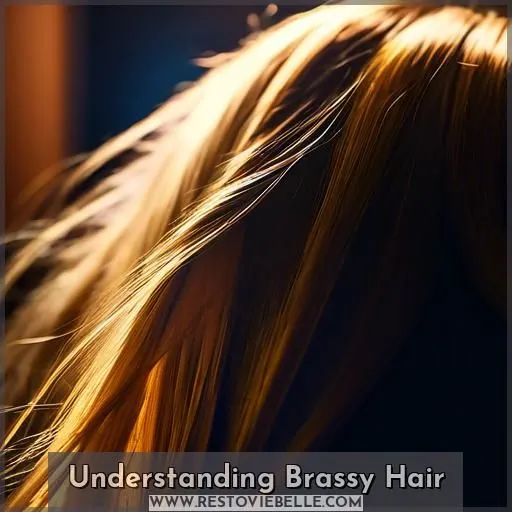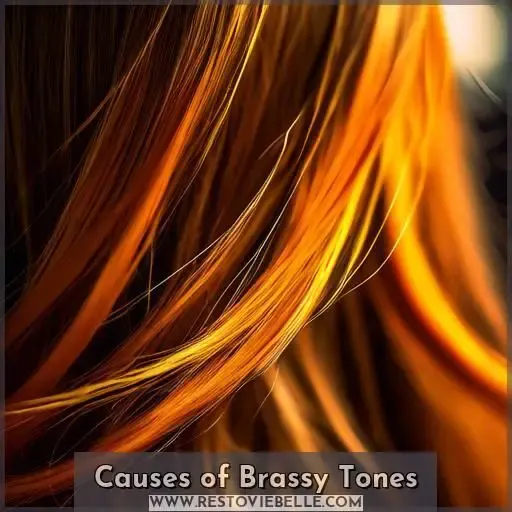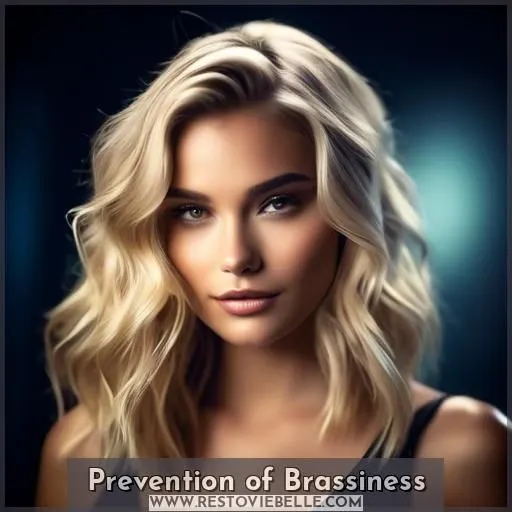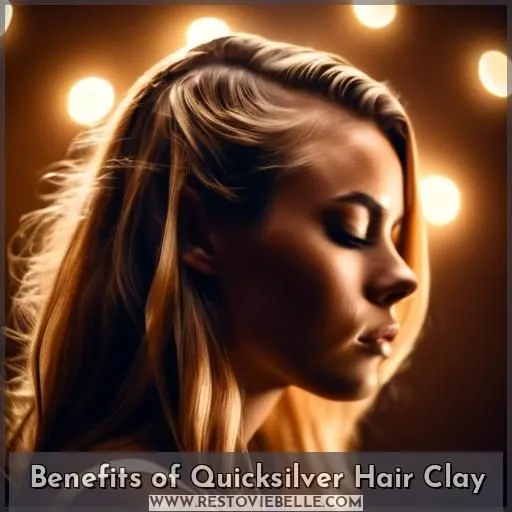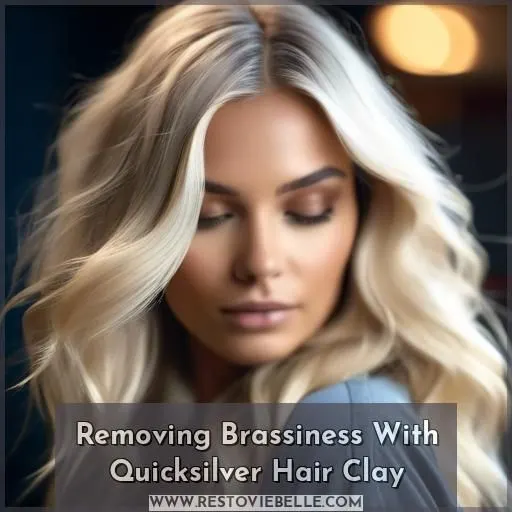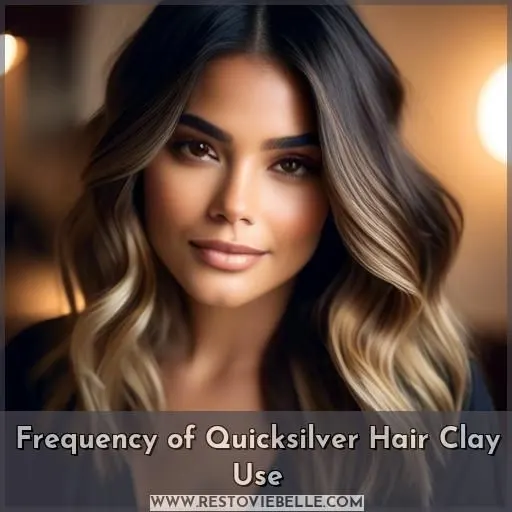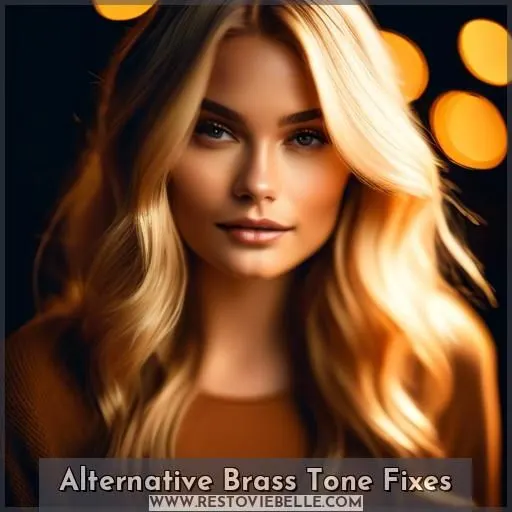This site is supported by our readers. We may earn a commission, at no cost to you, if you purchase through links.
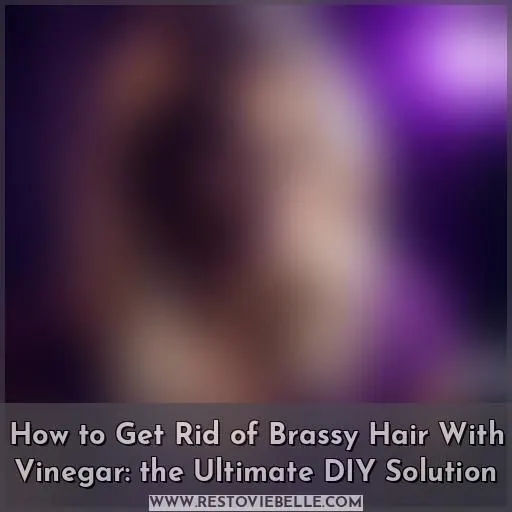
To get rid of brassy hair with vinegar, you’ll need to mix a few drops of red and blue food coloring into a cup of white vinegar.
Apply the mixture from roots to ends. Let it sit for 15-20 minutes, then rinse thoroughly.
The vinegar will help strip away unwanted brassy, orange tones. The food coloring deposits cool pigments to neutralize warmth.
This DIY method costs around $6 and lasts 1-2 weeks.
For longer-lasting results and to learn about additional brassiness-banishing options, you’ll want to explore further.
Table Of Contents
- Key Takeaways
- How to Get Rid of Brassy Hair With Vinegar?
- Understanding Brassy Hair
- Causes of Brassy Tones
- DIY Brass Tone Fix With Vinegar
- Prevention of Brassiness
- Benefits of Quicksilver Hair Clay
- Removing Brassiness With Quicksilver Hair Clay
- Frequency of Quicksilver Hair Clay Use
- Alternative Brass Tone Fixes
- Conclusion
Key Takeaways
- Mix red and blue food coloring with white vinegar to create a toner that neutralizes brassy tones.
- Apply the toner from roots to ends, let it sit for 15-20 minutes, then rinse thoroughly.
- This DIY method costs around $6 and lasts 1-2 weeks.
- To combat brassy hair, consider using purple shampoos, toning shampoos, or glosses.
How to Get Rid of Brassy Hair With Vinegar?
To get rid of brassy hair with vinegar, you can use an apple cider vinegar (ACV) rinse.
This rinse helps to restore the pH balance of your scalp, remove product buildup, and improve the luster of your hair.
To make an ACV rinse, mix one part Bragg’s Apple Cider Vinegar with five parts water in a spray bottle or hair applicator.
Apply the mixture to your hair, targeting both the scalp and hair shaft, and let it sit for 10-15 minutes before rinsing with cool water.
Follow up with a deep conditioner.
If you have sensitive skin, you can dilute the mixture with more water to make it less acidic.
Remember to use a new and clean spray bottle to avoid any residue from other products that may be harmful to your hair.
Understanding Brassy Hair
Brassy hair is a common issue faced by people with color-treated hair, especially those who’ve recently dyed their hair to a lighter shade. It’s characterized by unwanted warm tones, such as yellow, orange, or red, which can make hair look dull and unappealing. Brassy hair can be a problem for all hair colors, not just blonde or light shades. It’s caused by several factors, including the natural pigments in your hair, exposure to the sun, and the use of the wrong shampoo.
To combat brassy hair, there are several home remedies and professional treatments available. One popular DIY solution is using vinegar to neutralize brassy tones. Another option is using quicksilver hair clay, which can detoxify your hair and reduce brassiness. Additionally, toning shampoos and glosses can help maintain your desired hair color and prevent brassiness.
Causes of Brassy Tones
You might be wondering what causes those unwanted brassy tones to appear in your hair. The main culprits are the underlying pigments that weren’t fully removed during the bleaching process, environmental factors like UV exposure and hard water, and product buildup that coats your strands over time.
Bleaching Underlying Pigments
Delving further into the realm of brassiness, let’s confront its genesis: bleaching methods.
When you bleach, you’re purging pigment, but occasionally not all the latent color departs. This can leave you with undesired warm hues.
To avoid damage and ensure uniform pigment removal, consider a salon visit.
In the interim between appointments, vinegar toning and blue shampoo can be your allies in vanquishing brassiness.
Environmental Damage Impact
Environmental factors play a significant role in causing brassy hair tones.
Exposure to UV rays, chlorine or salt water, and pollution can lead to hair’s follicles absorbing unwanted pigments, resulting in brassy, orange or yellow hues.
To combat this, consider using an apple cider vinegar rinse, which can help restore pH, add shine, and seal the cuticle of your hair, neutralizing brassy tones.
Additionally, using a shower cap while swimming or wearing a hat when outdoors can help protect your hair from environmental damage.
Product Build-Up Effects
Product build-up on your hair can lead to brassy tones and dullness. Here are three ways to combat this issue:
- Use clarifying shampoos: These shampoos are designed to remove product build-up and impurities from your hair. Look for shampoos that contain ingredients like apple cider vinegar, EDTA, or sodium thiosulfate to effectively remove chlorine and mineral build-up.
- Rinse with distilled water: After washing your hair with regular water, give it a final rinse with distilled water to help remove any remaining minerals and leave your hair feeling softer and smoother.
- Deep conditioning treatments: Regularly use a deep conditioning treatment like a hair mask to give your locks extra nourishment and prevent damage caused by product build-up.
DIY Brass Tone Fix With Vinegar
For a cost-effective way to banish brassy tones, try mixing a simple concoction of red and blue food coloring with white vinegar. The food coloring creates a purple hue that neutralizes unwanted yellow-orange shades, while the vinegar adds shine—all for around $6.
Mixing Ratio
Ditch the brass with a DIY solution that’s as cost-effective as it’s empowering. Mix 2-1/2 cups of vinegar with a few drops of food coloring to strike the perfect ph balance, using natural ingredients. Yes, the vinegar smell is a badge of your savvy; think of it as the scent of liberation. Your hair gloss awaits.
| Ingredient | Quantity | Emotion Evoked |
|---|---|---|
| White Vinegar | 2-1/2 cups | Liberation |
| Blue Food Coloring | 10 drops | Control |
| Red Food Coloring | 3-4 drops | Power |
| Ginger Essential Oils | A dash | Warmth |
| Time Commitment | A moment of care | Self-empowerment |
Application Process
To apply the DIY brass tone fix with vinegar, follow these steps:
- Pour the toner mixture over your hair.
- Allow it to sit for 10 seconds.
- Rinse out the toner.
- Comb your hair and apply styling products.
For porous hair, be cautious with the application to avoid over-absorption and potential hair damage. The effects of porosity can vary, so adjust the application accordingly.
Results
The DIY vinegar solution effectively eliminates brassy tones and provides shine, but it’s not permanent and lasts for a week or two. It costs around $6, making it a cheaper alternative to chemical-filled boxed toners. However, safety concerns with vinegar and long-term effects are worth considering. A home remedy may not yield the same professional results as a colorist’s expertise.
Prevention of Brassiness
Prevent brassiness by addressing the root causes.
Filter your water to remove minerals that can cause brassiness.
Use chelating shampoo to remove build-up from chemicals or minerals.
Protect your hair from the sun and heat styling damage.
Dye your hair darker to hide brassy tones.
For a gentle home remedy, try an apple cider vinegar toning rinse.
To maintain hair health, use a clarifying shampoo and a deep conditioning treatment regularly.
Benefits of Quicksilver Hair Clay
You may have heard of Quicksilver Hair Clay, a powerful yet gentle clarifying treatment that removes brassiness and impurities from gray or blonde hair. It detoxifies strands, leaving them clean, soft, bright, and voluminous thanks to its deep conditioning and clarifying properties.
Benefits of Quicksilver Hair Clay
After addressing brassiness prevention, let’s explore the transformative realm of Quicksilver Hair Clay.
This bold, distinctive clay benefits your tresses by acting as a potent hair detox. It’s not merely a clarifying treatment; it amplifies hair volume, enhances silver and gray hair, and promotes overall hair well-being.
Envision it as your hair’s valiant protector, minus the cumbersome armor but with an abundance of radiance.
Ingredients and Application Process
To remove brassy tones from your hair, you can use a DIY solution made from red and blue food coloring and white vinegar. This mixture will neutralize yellow-orange shades, provide shine, and last for about a week or two. Here’s how to make and apply the toner:
- Mix 2-1/2 cups of vinegar, 10 drops of blue food coloring, and 3-4 drops of red food coloring in a small bowl.
- Pour the mixture over your hair and let it sit for 10 seconds.
- Rinse the toner out thoroughly.
- Comb your hair and apply styling products as usual.
- Air-dry your hair for an hour, then use a hair-dryer to see the full results.
This DIY solution is a temporary fix and not as permanent as chemical-filled boxed toners. It’s also cheaper, costing around $6. If you prefer a more permanent solution, consider consulting a colorist for professional results.
Frequency of Use and Results
To maintain your brassy hair at bay, you can use vinegar toner once a week or whenever you notice brassy tones reappearing.
Quicksilver Hair Clay can be used up to twice a week for extra clarifying or every 10-30 days for maintenance. This clay detoxifies hair, leaving it clean, soft, bright, and voluminous.
Additionally, you can use purple or blue shampoo to neutralize brassy tones and prevent brassiness.
Removing Brassiness With Quicksilver Hair Clay
To remove brassiness with Quicksilver Hair Clay, you’ll need a shower cap, the clay itself, a silicone-free natural conditioner, and Quicksilver Hair Squalane Oil. Start by mixing the clay, oil, and conditioner into a smooth paste, then apply it to your wet hair, concentrating on areas with brassiness.
Materials
To remove brassy tones from your hair, you can use a DIY solution with vinegar. Here’s what you’ll need:
- 2-1/2 cups of white vinegar
- 10 drops of blue food coloring
- 3-4 drops of red food coloring
Mix these ingredients together to create a toner mixture. Then, pour the mixture over your hair and let it sit for 10 seconds before rinsing it out. After rinsing, comb your hair and apply styling products. Allow your hair to air-dry for an hour, and then use a hair-dryer to see the full results. This DIY solution eliminates brassy tones, provides shine, and lasts for about a week or two. It costs around $6, making it a cheaper alternative to chemical-filled boxed toners.
Additionally, you can use white conditioner instead of vinegar for a matte hair effect. Repeat the treatment as needed, and consider wearing a hat to conceal brassy tones until you visit a salon for professional results.
Mixing
To mix the toner, combine 2-1/2 cups of vinegar, 10 drops of blue food coloring, and 3-4 drops of red food coloring.
The vinegar benefits include neutralizing brassy tones and adding shine.
The mixing ratio is essential for achieving the desired color neutralization.
Apply the toner mixture to your hair, let it sit for 10 seconds, then rinse it out.
This DIY solution is a cost-effective and quick way to eliminate brassy tones and improve the appearance of your hair.
Application
To apply the Quicksilver Hair Clay, follow these steps:
- After washing your hair with a clarifying shampoo, mix the clay, oil, and conditioner in a small bowl until it forms a smooth paste.
- Apply the mixture evenly to your wet hair, focusing on areas with brassiness.
- Cover your hair with a shower cap and leave it on for up to 40 minutes for a deeper brightening and clarifying treatment.
- Rinse the mask thoroughly from your hair and wash again if necessary, depending on your hair’s moisture needs.
Remember to use the clay mask up to 2 times a week for extra clarifying or every 10-30 days for maintenance. You can also use the clay blend as a dry shampoo for additional benefits.
Rinse
After slathering your hair with the QuickSilverHair Clay concoction, it’s time to rinse away the brass like last year’s fashion faux pas. This neutralizer isn’t just a flash in the pan; it’s your ticket to shine town. So, give your hair a thorough rinse, watch the color transform, and say goodbye to those unwelcome brassy gatecrashers.
Frequency of Quicksilver Hair Clay Use
Frequency of Use
The frequency of using Quicksilver Hair Clay to remove brassiness from your hair depends on the condition of your hair and the level of brassiness you want to eliminate. Here are some guidelines to help you determine how often to use the product:
- Extra clarifying: If your hair is particularly brassy or yellowed, you can use the QuickSilver Hair Clay mask up to twice a week for stubborn discolorations.
- Maintenance: For regular maintenance, use the clay once every 15-30 days to keep your hair bright and shiny.
- As needed: If your hair appears dull and yellow, you can use the clay whenever you notice these signs of brassiness.
Alternative Brass Tone Fixes
If the DIY vinegar toner doesn’t provide the desired results, you can try using a purple or blue shampoo to neutralize brassy tones. Hair glazes or glosses offer another option — they gently correct brassiness while adding shine and smoothness to your hair.
Purple Shampoo
If you’re looking for an alternative to vinegar toner, consider using purple shampoo. This shampoo is designed to tone down brassy, yellow tones in blonde hair.
It works by neutralizing the brassiness on the color wheel, leaving your hair with a cooler, ashy tone. Choose a purple mask or an ash toner for a more intense treatment.
For best results, use a beige-rich toner for blonde hair or a deeper shade of chocolate brown for brunette hair. Remember to use purple toner for yellow hair and blue toner for orange hair.
Blue Shampoo
Blue shampoo is a game-changer for brunettes who want to maintain cool, brass-free hair color. It contains blue-violet pigments that neutralize brassy tones, especially those that occur when hair is lightened. To use blue shampoo, follow these steps:
- Apply to damp hair: Gently massage the shampoo into your hair, ensuring even coverage.
- Lather and leave it to absorb: Let the shampoo sit for two to three minutes to allow the blue pigments to neutralize the brassy tones.
- Rinse: Thoroughly rinse your hair to remove the shampoo.
- Repeat application: If needed, repeat the process for a more intense toning effect.
- Follow with a blue conditioner: To maintain the results, use a blue conditioner to hydrate and protect your hair color.
Hair Glazes or Glosses
Hair glosses and glazes are gentle alternatives to dyeing for color correction. They add shine and smoothness to hair. Choose a toner opposite your current hair color on the color wheel. Use purple toner for yellow hair, blue toner for orange hair. Apply consistently over several weeks for best results.
Conclusion
Whether you’re battling brassy tones or seeking a long-term solution, vinegar offers a budget-friendly, DIY fix for getting rid of brassy hair.
But for lasting vibrancy and enhanced manageability, consider incorporating Quicksilver Hair Clay into your routine—its nourishing blend banishes brassiness while fortifying strands.
Explore professional options like glazes or specialized shampoos to neutralize unwanted warmth effectively.
With the right approach, you’ll achieve your desired, cool-toned hue with ease.

